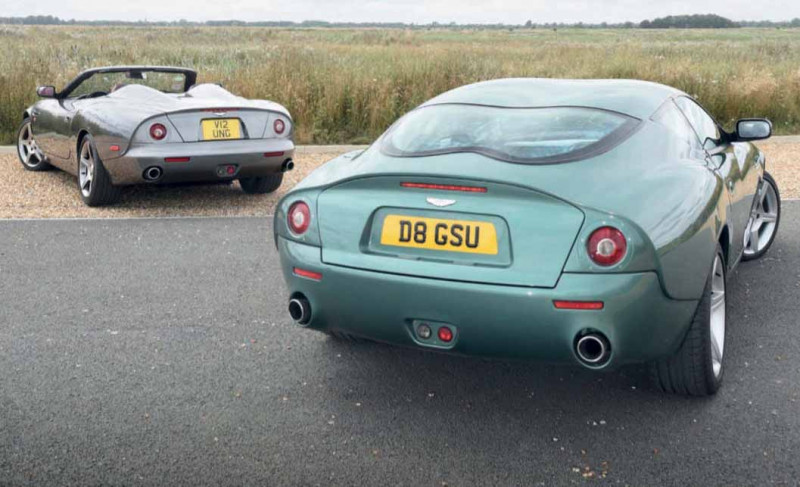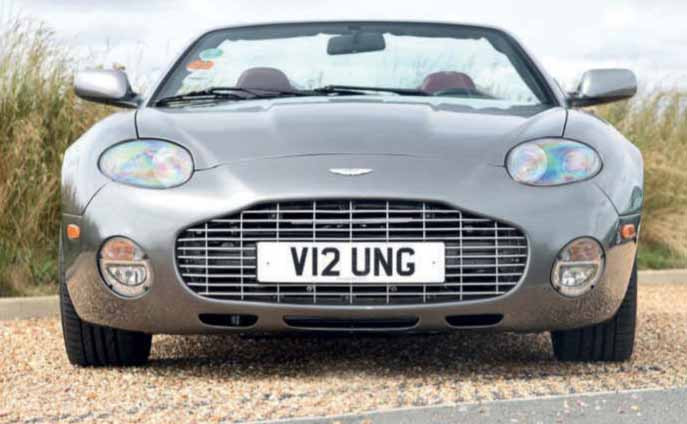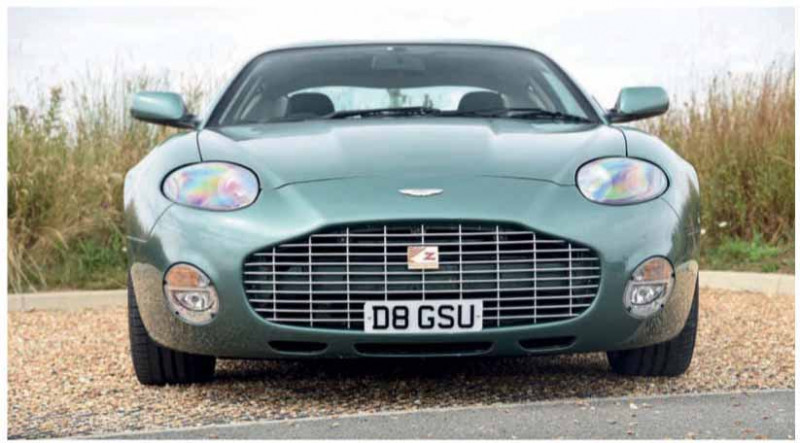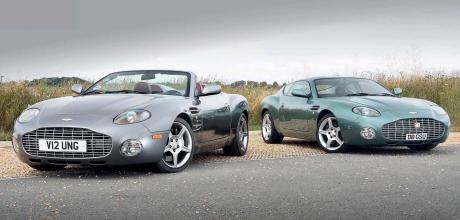2003 Aston Martin DB7 Zagato Coupe vs. DB AR1 Roadster
Arriving late in the DB7’s production, the limited-edition Zagato coupe and DB AR1 roadster from 2002 and 2003 respectively were an Italian take on this very British sports car.
WORDS & PHOTOGRAPHY PAUL WALTON
THE ITALIAN JOBS DB7 ZAGATO & AR1
DB7 ZAGATO AND DB AR1
At the end of the DB7’s production, the Milan-based coachbuilder, Zagato, designed a unique coupe and roadster based on the Vantage Volante. Just 100 were produced of each and we’ve tracked down a rare example of both.

Due to being designed by the Scot, Ian Callum, and then being built at a small factory in Warwickshire, the DB7 is as Italian as a full English breakfast or queuing in the rain. But when the Milan-based design house Zagato transformed the model into a pair of handsome, limited-edition sports cars in the early 2000s, its personality changed from a warm pint of real ale into a glass of fizzy Prosecco.
Although produced in relatively small numbers, by arriving towards the end of the DB7’s nine-year production run, the two cars represented a final flourish for this always popular model.

It also set the standard for the company’s future models that were just around the corner. The origin of the two cars stems from a chance meeting between Andrea Zagato, grandson of the design company’s founder, Ugo, and current CEO and Aston Martin’s own chairman, Dr Ulrich Bez, at the 2001 Pebble Beach Concours. The subject of previous Zagato-designed Astons inevitably came up and it wasn’t long before Bez approached the subject of renewing the collaboration.

“Ulrich and I were on the same judging panel,” explained Zagato in the 21 August 2002 issue of Autocar. “We’d never met before, but we hit it off. The following day we got talking again, and the idea came up of our two companies doing another car together – something very much in the spirit of the previous models. We decided to explore the idea, and the whole thing has grown from there.”
The car chosen as the base for the new project was the by now ageing DB7. Not only was its running gear well-proven but by being close to the end of its production, an exclusive limited edition would give the model a last minute sales boost.

Sketches by Zagato’s chief designer, Norihiko Harada, were soon presented to Bez and Aston’s new design director, Henrik Fisker, with approval given in early 2002. Aston then dispatched a standard DB7 Vantage Volante to Zagato’s Milan studio in February to be the basis of the prototype. Christened ‘Georgia’ by the project team, the body was slowly formed from hand-beaten aluminium.
The eventual production model, though, featured an aluminium bonnet, doors and boot with pressed steel used for the front wings and roof. Unlike previous Zagato-bodied Astons, whose rolling chassis were constructed in England before being transported to Italy to have their bodies fitted, the DB7 Zagato was constructed by Opac, a Turin-based specialist in low-volume cars. After being primed, they were transported to Aston’s new facility at Gaydon to be painted before being sent the 14 miles to Aston Martin’s small factory located outside Bloxham for final assembly. With this being a transitional period for the company, it’s thought a handful were also finished at Gaydon.
Apart from the front screen, every panel was different from the standard DB7 while the Volante’s chassis was cut by 2.5in. Front and rear overhangs were also made shorter by 2.5in and 6in respectively and the body was an inch wider.

The result was a handsome yet compact coupe that was clearly influenced by cars from the Sixties. “While everyone is getting bigger and heavier, we’re getting smaller and lighter,” said Fisker to Autocar. “I like that a lot.”
With its very short tail and a nose dominated by a massive grille, the car was very European in character. But although it featured plenty of the Italian company’s design cues – such as the double bubble steel roof and its tall rear haunches that were reminiscent of those of the famed DB4 Zagato – it was still a modern-looking car that subtly tipped its hat towards the original.
“We don’t see it as really retro,” continued Fisker, “we see it as more of a Zagato in the tradition of Zagato and Aston Martin. The idea of this car was, like the original DB4 and DB4 GT Zagato, for the DB7 and the DB7 Zagato to have a relation in design. So you couldn’t go off in some futuristic direction.”

The interior featured seats that were upholstered in an aniline-quilted leather with Zagato’s logo embossed in the headrest. Instead of the tight rear seats, there was a parcel shelf for luggage complete with leather straps.
Power came from the 435bhp version of Aston’s 5.0-litre V12 and a Tremec six-speed manual gearbox as fitted to the DB7 GT. Also taken from the car was the AP twin plate racing-style clutch, a revised quick shift gear linkage for shorter throws and a 4.09:1 final drive ratio rather than the 3.77:1 of the standard V12. Unsurprisingly, the car’s 184mph top speed and 0-62mph time of five secs were identical to those of the GT.
Although the DB7 Vantage suspension was retained, the dampers were unique to the Zagato and, according to Aston, were developed “specifically for enhanced performance and optimum precision handling.”
The prototype made a surprise appearance at the 2002 Pebble Beach Concours in August before making its official debut at the Paris Motor Show the following October. Although its £166,000 price tag made the Zagato over £60k more expensive than the DB7 GT, the press was still largely positive about the new model. “A breathtaking car,” was how Autocar described it, “and amazingly different from the DB7 itself, considering the hidden similarities.”

More importantly, so did the public with Aston later announcing that 200 confirmed orders had been taken. Production was later capped at 99 examples with one extra retained by the factory. The cars were bought by enthusiasts across Europe, including France, Germany, the Netherlands, Switzerland and the UK.
But with the shortened chassis making the Zagato viewed as a new car and therefore requiring homologation, it was never sold in America. Yet it was clear by the positive reaction that there was a market for a low-volume model like this. When Bez and Zagato met at the 2002 Pebble Beach Concours for the coupe’s initial reveal, Aston’s CEO enthused about driving a DBR1 at Le Mans a few weeks earlier. From there, the idea was born to produce a roofless version. The shape was again the responsibility of Harada who had it sketched out by the end of the year. Although it followed the same basic lines as the coupe, by using the standard Volante chassis, the tail was longer. The rear deck behind the cockpit featured a double bubble shape, the doors were slightly longer and there were three new air ducts below the still sizeable grille. Called the DB AR1 or American Roadster, since the car was aimed at the country’s warm, dry states such as California, there was no roof.
When the DB AR1 was revealed at the Los Angeles Motor Show in January 2003, it was purely for feedback. “If the reaction is as positive as that for the DB7 Zagato,” explained Bez, “we will produce a limited number.” Due to the response, Aston later announced the DB AR1 would reach production, going on sale later the same year. “Within days, we had 125 enquiries,” said Bez in the 12 February 2003 issue of Autocar. “Sixty two clients immediately made a down payment of $50,000 each.”
Once again 99 would be produced for customers with one extra for Aston itself. As well as the same 435bhp version of the V12 and six-speed manual transmission as the Zagato coupe, the DB AR1 had the option of the six-speed automatic gearbox which, as per the DB7 GT, only came with the 420bhp V12.
Unlike the DB7 Volante, with no ungainly roof pack to clutter up its otherwise clean lines, the result was a very handsome and striking-looking car. “The AR1 is an old-style roadster with an authentic character,” continued Autocar. “In a class that increasingly uses electro-hydraulic hard tops and wind deflectors to keep nature at bay, the AR1 is a refreshing exception.”
Although the majority of the cars did head to the States, a tiny handful remained in Europe including the 61st example that was made in right-hand drive by the factory for a British customer. According to the website howmanyleft.com, there’s just one DB AR1 in the UK yet it’s not that one; it’s the Mercury Grey example seen here that together with the Aston Martin Green coupe alongside it, belongs to DB7 enthusiast Gary Ungless.
He bought the Zagato (number 34) n 2009 when he was looking for something interesting to invest in. When the fourth DB AR1 came up for sale in America two years later, Gary knew he needed to have it to complete the set, bravely buying the car online and therefore unseen. The result is a handsome and, in this country at least, a potentially unique pairing.
I’ve never previously considered either car to be particularly good looking, thinking their proportions were all wrong and the voracious grilles too large. Yet thanks to its slightly shorter length yet chunky design, the coupe has a masculinity that the usually feminine DB7 coupe misses out on while the roadster appears long and elegant. There’s also a definitive Italian flavour about them and it would be easy for the misinformed to imagine their heritage stems from Maranello rather than the considerably less continental Warwickshire.
With Gary kindly offering me a drive of both, I climb into the Zagato first. As mentioned earlier, the interior is trimmed aniline leather, a type of leather that’s coloured with a soluble dye that doesn’t alter its colour or hide its blemishes leaving a very natural looking finish. Since it also offers very little protection, it’s an unusual choice for a car interior and results in the leather becoming worn and discoloured in places like an old leather jacket. I find the same dials and switchgear as the DB7 Vantage a huge disappointment for a car that originally cost a hundred and sixty grand. For that kind of money, I was expecting a cabin that looked and felt much more bespoke. By weighing 60kg less than a standard V12 coupe, I was also expecting the Zagato to feel significantly different from the DB7 GT I drove for issue six. But other than the firmer dampers making the car slightly more composed through corners, it’s difficult to differentiate between the two.
Yet with the V12 always offering the same level of strong and powerful acceleration as the GT, I’m not complaining. With the seemingly endless delivery of its power arriving more smoothly than a Marvin Gaye song, Aston Martin’s 5.9-litre remains a masterful engine. And although refined, the cabin is still filled with a deep growl when I nail the throttle.
The manual ‘box with its short, snappy and accurate changes is the perfect match for the engine. Although I’m often in the minority by liking the semi-automatic ‘box in the Vanquish, there’s always a real joy to snicking the lever down to third, balancing the throttle through a corner and then nailing it on the exit.
On paper, the DB AR1 should feel similar to the Zagato. As a manual transmission model, it has the same 435bhp V12 and at 1,858kg, weighs a mere 8kg more resulting in the same five-second dash to 62mph. Yet as I squeeze the pedal, I reckon the response of the V12 is a little quicker and therefore the acceleration a tad sharper. There’s no doubt this has been caused by the lack of weather protection since convertibles always feel faster than their coupe counterparts.
It’s for this reason why I prefer the DB AR1 over its Zagato sibling. Admittedly, with the leather being treated to protect it from the elements, the interior feels even more like that of a standard DB7, but the lack of a roof, even a rudimentary one, results in an excitement the coupe lacks.
Both, though, remain important models in Aston Martin’s recent history. Not only did they sign off production of the DB7 in style but in terms of their size, image and performance they set the standard for the company’s future cars. As Fisker himself said in Autocar, the Zagato was a good indicator as to where Aston was heading. There’s no denying the DB7 is the most British of cars but like having focaccia with a full English, because of these two special cars, a little part of it will forever be Italian.
Thanks to: owner of the two cars featured here, Gary Ungless (astonowners.com), plus Rob Smith
20/20 vision
Zagato wasn’t the first Italian carrozzeria to redesign the DB7; Italdesign got there first in 2001 with the remarkable Twenty Twenty concept
Just 20 yards from where the Vanquish had made its debut at the 2021 Geneva Motor Show, another special Aston Martin was being unveiled. But as a concept based on a DB7 Vantage Volante, it was a very different kind of car.
The work of legendary designer, Italdesign’s Giorgetto Giugaro, the Twenty Twenty was a two-plus-two targa top sports car. The body was based on an exposed aluminium space frame with bonded non-load-bearing carbon fibre and plastic composite body panels. “Our idea was to mix a classically beautiful design with technology that shows off our engineering skills and combines the exposed space frame with the hedonistic style,” said Giorgetto’s son, Fabrizio, in the 8 August 2021 issue of Autocar.
Unlike the later Zagato design, the Twenty Twenty’s interior was very different from the car it was based on. Trimmed in a terracotta-coloured leather and featuring several brushed aluminium accents for a contemporary feel, the dials were housed in a pod on the steering column rather than set into the dashboard. Yet although the car garnered plenty of positive attention, with Autocar magazine calling it both individual and unique, there was never any chance the Twenty Twenty would reach production. “We’re flattered that international designers such as Giugiaro want to pay attention to Aston Martin,” explained Ulrich Bez at the time. “It’s an interesting design, but it’s Giugiaro’s vision. They designed it, built it and executed it. We’ve given our opinion. But it’s not a concept for the DB9.”


